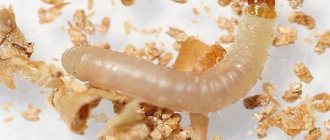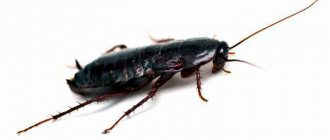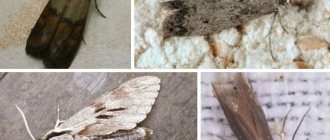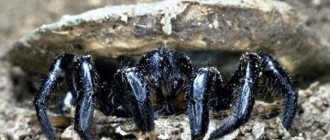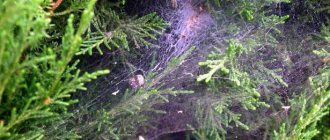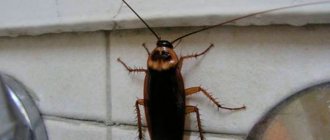Description and characteristics of the insect
People call moths all insects belonging to the order Microlepidoptera.
Adults are similar in appearance to small butterflies, which are mainly nocturnal or crepuscular .
Another feature of the moth is the structure of the jaw apparatus. It is a gnawing type, which allows these insects to easily feed on dense and rough food.
Their powerful jaws help them chew even wood and fruit seeds, and their unpretentiousness in food determines the wide distribution of these pests.
greater damage to plants, tissues and products when it is in the caterpillar stage.
Appearance of a moth
Although there are many types of these insects, they are similar in appearance.
The moth has an inconspicuous appearance, the size is 5-9 mm.
Their size does not exceed 5-9 mm. They fly poorly and are dull in color. There are 2 main types of moths living in houses: clothes moths and furniture moths. The first has a light brown color, and the second is gray, but with a quick inspection it is difficult to identify these differences.
Externally, the caterpillars of these insects and other species of butterflies are no different. They rarely exceed 1.5 mm in length, so they are difficult to notice. The larvae are sedentary, love dark places and eat a lot.
How long does he live?
Before becoming adults, these insects go through the egg and larval stages. The caterpillar lives from 3 to 10 months. At this time, it actively feeds and destroys clothing, furniture, food, and forms a cocoon in which its further development occurs.
After the wings appear, the adult does not live long - only 2-4 weeks (this depends on the type of pest).
expectancy at all stages of moth formation is about a year.
Where does it live?
Depending on the species , the habitat of insects will be different. Food moths lay eggs in food.
Food moths lay eggs in food.
It can be:
- cereals;
- candies;
- vermicelli;
- cookies, etc.
Furniture moths feed on outerwear made from natural woolen fabrics, fur, etc. They often develop in closets and suitcases where sunlight does not penetrate.
Indoor moths can develop anywhere in the house where there are favorable conditions for it, as well as products made from natural fabrics such as cotton, silk, etc.
In addition, these insects can live on different plants (cabbage, potatoes, poplar, chestnut, wormwood) and harm them. They also live in beehives, where they feed on beebread, honey and wax.
In nature, some types of moths feed on the horny formations of animals and birds. They settle in their burrows or nests. There is a species of moth that lives in the horns of buffalos or antelopes, and in the shells of dead turtles.
Types of moths
There are two types of moths and several of their subspecies - indoor and kitchen moths. Accordingly, the first one spoils things - upholstery, clothes, furniture. The second one causes damage to food products (cereals, flour, mushrooms).
Now let's talk in more detail about the types of moths that can live in rooms.
Clothes
The butterfly is yellow with a purple tint and has a body length of about 8 mm. Lives in closets and closets with clothes. Lover of all types of natural fabrics - from drape to silk. It lays larvae in folds and on the inside of clothing. Causes irreparable damage to the wardrobe, as it eats large holes in the fabric.
Fur coat
Yellowish-gray, with dark dots on the tips of its wings, the butterfly prefers fur. Moreover, it is so strong that no protective covers will become an obstacle for it. It eats the fibers completely, or simply cuts them off to clear a path for itself.
The absence of fur products does not bother her; with no less pleasure she absorbs other natural materials (wool, felt, etc.)
Furniture
Yellow with a delicate golden tint, the butterfly is the most prolific of its relatives. It settles in stuffing and lays eggs under furniture. The larvae of this type of moth crawl out before pupating, gnawing holes in the upholstery.
Read here: Unpleasant smell in the apartment - ways to get rid of and effectively eliminate the causes
Kitchen moth
Another type of moth is the kitchen moth, which also has several subspecies:
- Cereal. White with a silvery tint, the butterfly feeds on grain, cereals, dried fruits, and seeds. Calmly moves around the kitchen, carrying grains fastened together.
- Floury. A gray butterfly whose larvae live in flour. They contaminate it with waste and molting waste, which is why the flour collects in small lumps.
- Mushroom. Gray-brown butterfly. Its native habitat is the forest, but it also takes root well in the kitchen. It multiplies in bulk products and dried fruits.
Life cycle of a moth
The moth lays 50-80 eggs per clutch in a dark place, the size of which is no more than 0.5 mm. During their development, a caterpillar appears. On clothing, females choose places near pockets and on collars; They love old rugs or blankets that have not been used for a long time.
Moth eggs go through a long stage of development to the state of an adult.
The caterpillars begin to feed on what the eggs were laid in (fabric, food, etc.). After emerging from the pupa, females soon begin to mate with males and lay eggs. They do this not far from the place where they appeared. After mating and before laying eggs, 5-6 hours pass, and after another 5-6 days the female dies, because fulfilled its purpose - gave birth to offspring.
If we talk about clothes moths, they produce only 1 generation per year, while, for example, cabbage moths can produce up to 5-6 generations in the spring-autumn period.
The benefits and harms of moths
What role does a moth play in nature? It is one of the components of the cycle of substances in the natural environment. Moths destroy and recycle the horny and hairy components of the world around us. She, in turn, is food for birds and small
mammals.
But what about the person? Is it really possible that this insect can’t bring anything other than frustration from spoiled food, clothes and furniture? It turns out it can.
Wax moth larvae are beneficial to humans. The caterpillars of this moth live in hives and feed on wax. Back in the 17th century, people noticed that an extract obtained from wax moth larvae helped cure tuberculosis. Who knows, maybe in the future other useful properties for humans of the moth we all know will be revealed.
Pest varieties
The most common:
- Food. There are several types of it. They differ from each other in the products in which they prefer to reproduce . They have some external differences in the color of the wings: the grain moth is off-white, the flour moth has a black-brown pattern, and the granary moth is black-orange. The length of the wings in all individuals does not exceed 10 mm. The larvae are transparent white, at 6 weeks of age they reach 1.5-2 mm and begin to pupate.
- Clothes. Smaller, reaching no more than 3 mm in length. There is no pattern on her wings; they are light brown. The larvae are yellowish in color with a brown head.
- Furniture. Similar to the previous species, but the size of adults reaches 8 mm. The coloring is slightly darker and the larvae are white. It is distinguished by a well-developed jaw apparatus, providing the necessary pressure for eating dense food. Has a large intestine and stomach.
- Cabbage. The gray color makes it inconspicuous. There is a light pattern on the wings. This color allows for good camouflage. These insects are larger in size than house moths . The duration of maturation of the larvae in the egg is 72 hours. The caterpillars are 12 mm long and green in color. First they live in the lower part of the leaf, and then crawl to its upper part, where they create a cocoon. During the maturation period, 4 moults occur.
- Poplar. It has an inconspicuous appearance, its length is up to 7 mm. There is fringe on the hind wings. It enters the house through open windows. The maturation of the larvae lasts 2-3 weeks, they have a yellowish tint.
- Potato. They are distinguished by a grayish-brown tint. The wings have a pattern of brownish-yellow stripes and spots, the edges indicated by dark lines. The fringe on the hind wings larger than the wings themselves. The length of insects is 10-16 mm. The larva reaches 10-12 mm, it is almost completely transparent. Its color depends on its diet: the one that feeds on leaves becomes green, and the one that feeds on tubers becomes pale gray.
- Wax. Quite large, reaching 20 mm, while males are smaller than females. At rest, females fold their wings and males spread them. The period of egg development is 10 days. As the caterpillar matures, it molts 10 times.
The food moth is an insect for which your kitchen can become its habitat.
How does it reproduce
To fight these insects, you need to know how moths reproduce .
This process includes steps such as:
- egg;
- a caterpillar that turns into a chrysalis;
- adult.
Only male moths fly. The female crawls around in search of a secluded place in which she lays eggs.
Moth caterpillars eat a wide variety of things and foods.
The rate of egg hatching directly depends on the ambient temperature:
- if it is less than 13°C, the ripening period is up to 37 days;
- at 33°C – 7 days.
Reasons for appearance
To effectively combat moths, you need to find the source and reasons for its entry into the apartment .
The main reasons for the appearance of moths:
- Flew in through an open window on its own. If there is no protective net on it, then this insect can fly into the house and take root in it. Using a mosquito net will eliminate such troubles.
- Brought into the house along with things. These could be woolen or knitted clothes that you took from your grandmother. It is not necessary that these are adult pests: their larvae, which are difficult to notice, are sufficient. To prevent this from happening, things should be well ventilated and left in the sun for several hours before bringing them into the house.
- Came with old furniture. The larvae can be found in the upholstery of old sofas. They look like small white cocoons. Almost all old furniture is contaminated, so if there is a need to bring it into the house, you must first treat the fabric with special means.
- Introduced by domestic animals . Larvae may be on their fur, so you should periodically wash the animals with special shampoos that help get rid of any parasites.
- It came with cereals that were improperly stored in a warehouse, or with dried fruits and mushrooms purchased at the market.
Most often, moths enter an apartment along with new things that contain fur and wool.
What does furniture moth look like and what happens?
Entomologists know more than 30 thousand species, most of them live exclusively in the wild, and only 14 species prefer cozy human habitation. Among the remaining indoor species, the most common ones can be identified:
• clothes (clothes); • fur coat; • wool; • grain (food lives in the kitchen or pantries); • fruit; • potato; • cabbage; • wax; • some types of furniture moths, etc.
From the names of these subspecies it is easy to understand their main food. However, this parasite easily adapts at home and, if its usual food disappears, it can easily switch to another. In any case, the caterpillars prefer to feed on natural products (carpets, fabric, clothing, fur, etc.); sometimes they consume semi-synthetic materials; they rarely consume synthetic products. Only the larvae cause harm; butterflies are dangerous only for their role - their task is to reproduce the species (lay eggs). One butterfly can lay from 10 to hundreds of eggs. Therefore, you need to fight both larvae and butterflies.
What causes furniture moths?
The reasons for the appearance of furniture moths are man himself. This happens when the larva is transferred from an infected room or along with furniture, carpets, etc. Therefore, when making a new purchase, check your purchase at home for cleanliness. The furniture parasite can camouflage itself well, but traces of it can still be detected: small cobwebs on furniture (usually on the inside of doors, near corners, etc.), remains of small cocoons (small fibers), etc.
The larva itself is difficult to notice because it is very small - it looks like a very small caterpillar (up to 15 mm long), white or yellow. But if detected, it is recommended to destroy it so that a colony of pests does not form. Even one pest is capable of producing offspring and multiplying.
How to fight insects
It doesn’t matter which way the moth got into the apartment. It is necessary to begin fighting it immediately after identifying the first adults or larvae. The sooner you start doing this, the faster you will be able to get rid of the pest.
Chemicals
Previously, tablets made from a mixture of naphthalene and camphor were often used, but the danger is that their vapors in high concentrations are harmful to humans .
Now there are many safe means:
- "Antimol." Available in tablets. It is enough to put 3-4 pieces in the closet. The tablets are valid for 21-28 days, then they are thrown away. The product is used to repel, not kill, moths.
- "Dezmol" is a drug similar to the previous one. Available in tablets.
- "Molemore." Validity is up to 6 months, but no more than 2 records can be used in one room. The drug repels, but does not destroy, insects.
- “Suprozol” is a drug in the form of an aerosol. Spraying in places where moths accumulate helps to effectively destroy adults and larvae.
- “Supromit” is a liquid product used to treat furniture surfaces. Its validity period is several months.
- "Moskitol" is a product in the form of plates. They are laid out in places that they want to protect from the penetration of moths.
- "Raid Antimol" is a popular drug. Available in the form of plates, gel or spray. The method of use depends on the release form.
- "Raptor". When sprayed onto clothing, it leaves no traces on it and has a pleasant smell.
Antimol is a reliable means of killing moths.
Special sections effectively repel moths. They have a pleasant aroma and can be safely used even to protect children's things. Mount them at the top of the cabinet. 1 section is capable of protecting a space of up to 0.5 m³. At the same time, in a room with an area of up to 15 m³, no more than 2 pieces can be used. The section is valid for 4-6 months.
Destruction of larvae
To fight them you will have to make efforts, because... larvae hide in the most inaccessible places. Clothes moths are easier to remove than food moths. To do this, take things outside and shake them out well, then leave them in the sun, and if possible, wash them at 60°C. After this, they are treated with moth repellents, and the cabinets are also treated.
If food moths are detected, you must urgently get rid of all contaminated food products. Adults are destroyed using aerosols. The shelves on which the products are located are treated with liquid agents or sprays (they must be stored in sealed containers).
Using aerosols, moth larvae are destroyed.
What folk remedies exist
Many people are afraid of the toxicity of chemicals, so they prefer proven traditional methods.
It must be remembered that most of these products do not destroy moths, but simply repel them.
Commonly used folk remedies:
- Orange peel. Place it in places where moths can lay eggs. It repels adult insects. The peel should be changed at least once a month.
- Laundry soap. They put it in the closet and also wash furniture with it. The downside is that the smell gets absorbed into the clothes.
- Lavender, wild rosemary, tobacco, chamomile, fir. It is enough to change bouquets of these herbs once every six months.
- Fir or lavender oil. Place an open bottle in the closet or soak cotton wool in it.
- Geranium. It is enough to have 1 such plant in a room, and its smell will effectively repel pests. It is better to place the flower on the window so that insects cannot get into the house.
- Rosemary, garlic, cloves. They are placed in jars with cereals.
- Vinegar. They are used to treat the surfaces of bedside tables, cabinets, and storage rooms.
- Temperature. Moths are afraid of both heat and cold. Clothes should be washed at 60°C, exposed to the sun at a temperature of about 30°C, or exposed to frost – 10°C.
Folk remedies can help fight moths.
Moth control products
After cleaning, you can begin treating the room in various ways. Below you will find detailed instructions on how to deal with moths.
- To destroy indoor moths, you can purchase ready-made products - an aerosol, a fumigator or a section.
- All surfaces of furniture, cabinets, and rooms are treated with an aerosol. After use, do not enter the room for several hours, then be sure to ventilate it. Not suitable for use in the kitchen.
- Fumigators can be used throughout the apartment, as they do not emit substances harmful to humans. The downside is that the coverage is small, so it is advisable to install several devices. Completely gets rid of pests in a few days.
- Sections are almost ineffective in controlling moths, but are excellent for repelling females.
- Natural remedies are best for killing kitchen moths. Thoroughly treat all surfaces with baking soda solution. Wash the cracks of the kitchen set with water and vinegar diluted in it. Place the remaining food in hermetically sealed jars.
- Check plumbing fixtures for serviceability and repair any leaks.
- Place allspice grains, bay leaves or chestnuts in the cupboards.
- It is advisable to cover the ventilation holes with gauze.
Read here: How to sew an apron: a step-by-step master class on making a kitchen apron with your own hands (90 photos)
Prevention
It is always easier to prevent moths from appearing than to fight them, so you must adhere to the following rules:
- Before bringing food, items or old furniture into your home, carefully check them for the presence of larvae and adult moths.
- If you find contaminated food, throw it away.
- Wash items from second-hand stores at 60°C;
- Ventilate your kitchen cabinets periodically. If you have an ultraviolet lamp, it can be used instead of sunlight.
- Place a clove of garlic in the container with cereal.
- Have geraniums in your house.
- Place anti-moth tablets in the cabinets.
Use aromatic oils in cabinets and cabinets with food, which not only repel moths , but also smell pleasant. Compliance with the described rules and recommendations will help protect the house from the appearance of moths, and if this dangerous pest penetrates it, then effectively fight it.
Previous
MothWhat moth larvae look like and how to get rid of them
Next
MothUseful tips and recommendations on ways to destroy cabbage moths
Fighting furniture moths - how to destroy furniture moths at home
In order to start fighting a furniture parasite at home, you need to know what it looks like and what it is afraid of. This knowledge will help you get rid of the problem forever.
Remedies for furniture moths are effective
It is recommended to use chemicals to combat larvae and butterflies:
• tablets “Dezmol” or “Antimol”; • “Prayer” or “Molemore” plates; • aerosols “Combat”, “Raptor”, “Armol”, “Clean House”, etc.
All these insect control products are capable of destroying the pest (larva and butterfly) at home in a short time. To completely get rid of the problem, it is recommended to follow the instructions for use (description of the drug.
